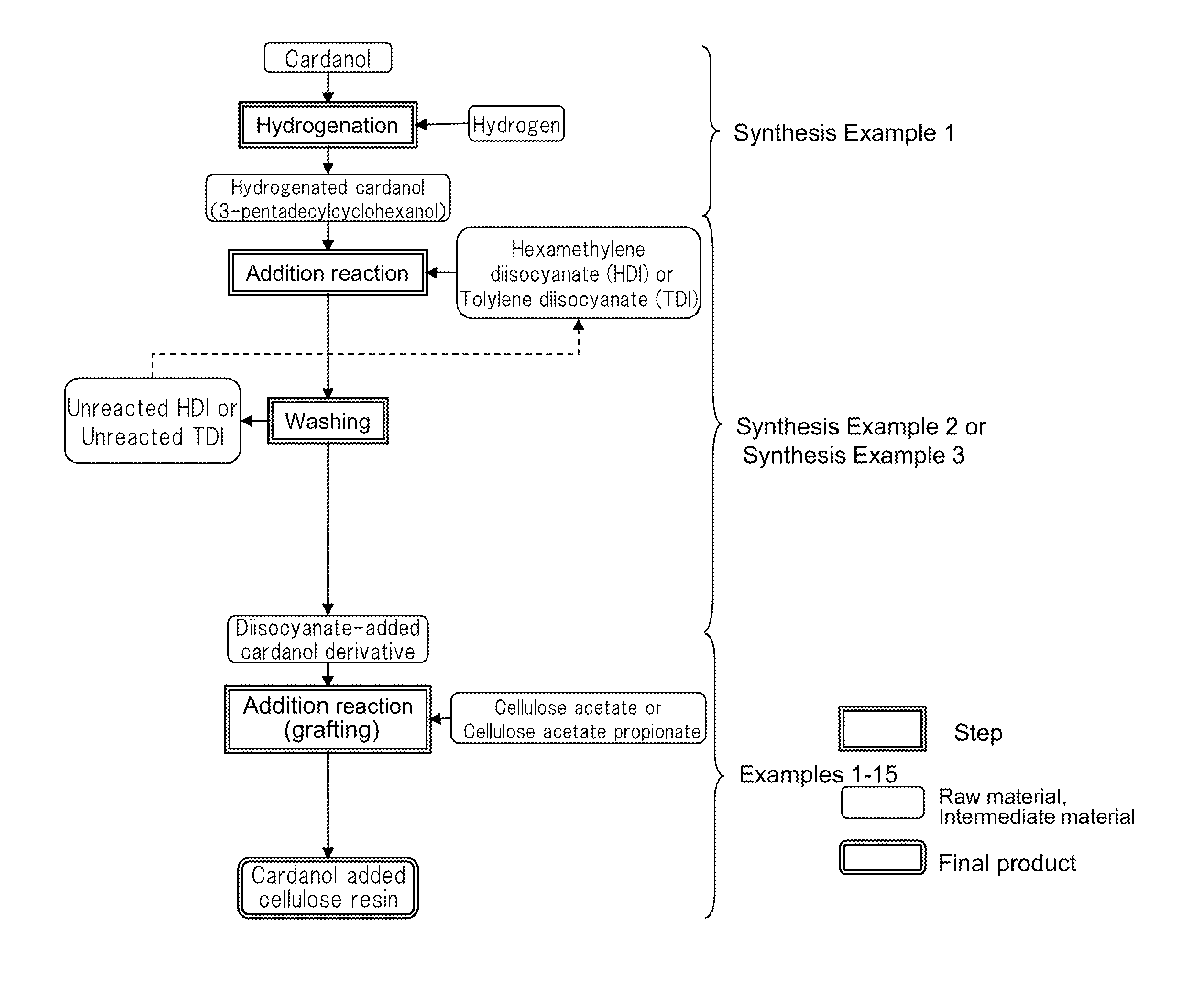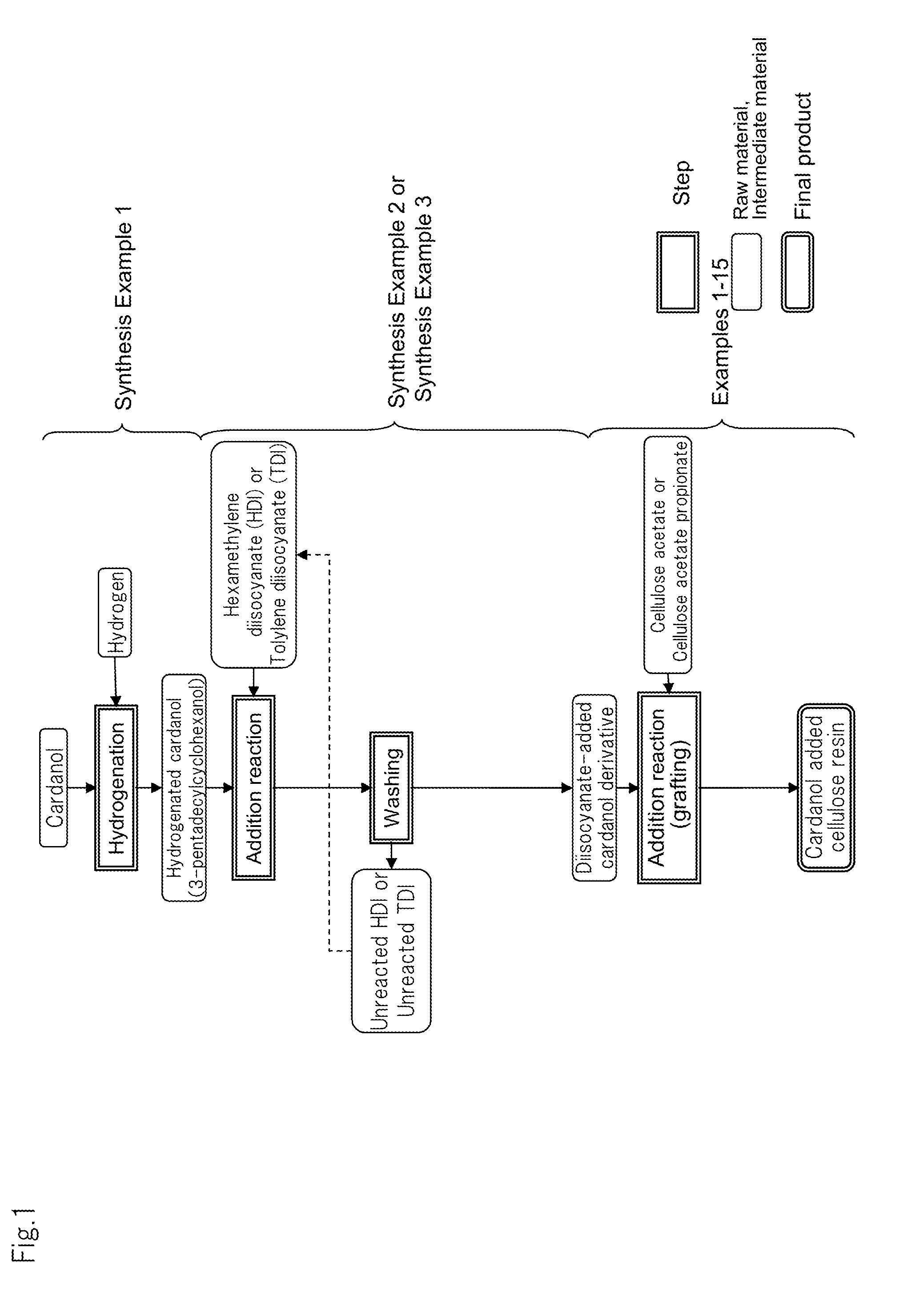Cellulose resin and process for producing the same
a technology of cellulose resin and cellulose resin, which is applied in the field of cellulose resin and a process for producing the same, can solve the problems of low water resistance high water absorbability, etc., and achieve the effects of improving heat resistance, strength and water resistance, and improving thermoplasticity (moldability), high vegetism
- Summary
- Abstract
- Description
- Claims
- Application Information
AI Technical Summary
Benefits of technology
Problems solved by technology
Method used
Image
Examples
synthesis example 1
Preparation of Hydrogenated Cardanol (3-pentadecylcyclohexanol)
[0146]In a batch-system autoclave of 1.0 liter in internal volume, cardanol (20 g) obtained by distillation purification of cashew nut oil treated with heat, 2 g of ruthenium / carbon catalyst (Ru: 5% by mass) and tetrahydrofuran (20 mL) were placed and hydrogen was pushed in at 20 kgf / cm2 (1.96×106 Pa) under room temperature and stirred at 80° C. for 3 hours to perform a hydrogenation reaction. Thereafter, the solution was taken out from the autoclave and filtered by use of a membrane filter made of Teflon (registered trade mark) and having an average pore size of 0.2 μm to remove the ruthenium / carbon catalyst. The obtained filtrate was treated under reduced pressure while heating to distill away tetrahydrofuran. As a result, hydrogenated cardanol (20.6 g) was obtained as a white solid substance at room temperature.
[0147]The purity of the obtained hydrogenated cardanol was measured by liquid chromatography (product name: ...
synthesis example 2
Synthesis of Diisocyanate-Added Cardanol Derivative 1
[0149]The temperature of hexamethylene diisocyanate (HDI) (84.5 g (0.50 mol)) was raised to 50° C. while stirring. To this, hydrogenated cardanol (15.5 g (0.05 mol)) prepared in Synthesis Example 1 was added and continuously stirred at 80° C. for 3 hours. After the reaction solution was cooled to room temperature, acetonitrile (300 mL) was added. The reaction solution was allowed to stand still in a refrigerator overnight. Thereafter, a precipitated solid substance was separated by filtration and dried under vacuum to obtain a diisocyanate-added cardanol derivative in which HDI and hydrogenated cardanol were bound in a ratio of 1:1, as a white powder (18.2 g (0.04 mol)).
[0150]The obtained sample (diisocyanate-added cardanol derivative) was measured by liquid chromatography (product name: LC-10ADVP manufactured by Shimadzu Corporation). The purity was 92% by mass.
[0151]Furthermore, the solvent was distilled away from the filtrate b...
synthesis example 3
Synthesis of Diisocyanate-Added Cardanol Derivative 2
[0152]The temperature of tolylene diisocyanate (TDI) (28.2 g (0.16 mol)) was raised to 50° C. while stirring. To this, hydrogenated cardanol (25.0 g (0.08 mol)) prepared in Synthesis Example 1 was added and continuously stirred at 80° C. for one hour. After the reaction solution was cooled to room temperature, hexane (300 mL) was added. The reaction solution was allowed to stand still in a refrigerator overnight. Thereafter, a precipitated solid substance was separated by filtration and dried under vacuum to obtain diisocyanate-added cardanol derivative 2 in which TDI and hydrogenated cardanol were bound in a ratio of 1:1, as a white powder (20.6 g (0.04 mol)).
[0153]The obtained sample (diisocyanate-added cardanol derivative 2) was measured by liquid chromatography (product name: LC-10ADVP manufactured by Shimadzu Corporation). The purity was 98% by mass.
[0154]Furthermore, the solvent was distilled away from the filtrate by an eva...
PUM
| Property | Measurement | Unit |
|---|---|---|
| pressure | aaaaa | aaaaa |
| pressure | aaaaa | aaaaa |
| pressure | aaaaa | aaaaa |
Abstract
Description
Claims
Application Information
 Login to View More
Login to View More - R&D
- Intellectual Property
- Life Sciences
- Materials
- Tech Scout
- Unparalleled Data Quality
- Higher Quality Content
- 60% Fewer Hallucinations
Browse by: Latest US Patents, China's latest patents, Technical Efficacy Thesaurus, Application Domain, Technology Topic, Popular Technical Reports.
© 2025 PatSnap. All rights reserved.Legal|Privacy policy|Modern Slavery Act Transparency Statement|Sitemap|About US| Contact US: help@patsnap.com



